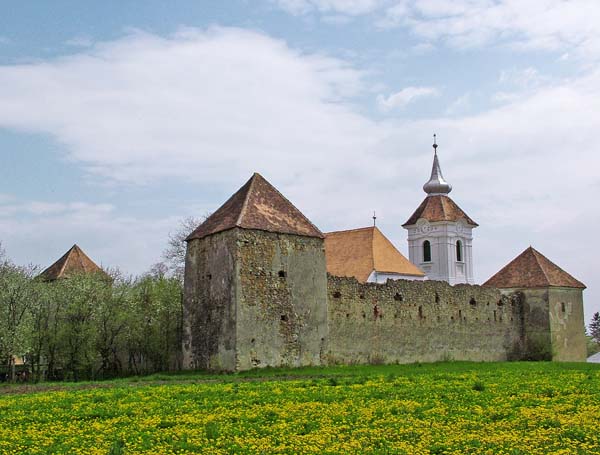Bezidu Nou / Bözödújfalu este un sat în jud. Mureș, în fostul Scaun secuiesc al Mureșului, cunoscut prin faptul că a găzduit din perioada Reformei ( probabil ) și cel puțin până la al Doilea Război Mondial o comunitate de sabatarieni, ultima rămasă atunci când persecuțiile împotriva acestui cult au încetat, la mijlocul secolului al XIX-lea. Sabatarienii au apărut încă din secolul al XVI-lea în Polonia și Transilvania, ca o formă extremă și iudaizantă de unitarianism, tolerată tacit până spre jumătatea sec. al XVII-lea. Reprezintă doar unul dintre multiplele cazuri de secte iudaizante din istoria creștinismului ( ex. subotnicii în Rusia sec. XVIII-XIX ).
Se pare că reapariția sabatarienilor ca o comunitate acceptată și tolerată a avut loc la 1868, când s'au organizat în Bezidu Nou / Bözödújfalu ca obște evreiască. Până atunci, ei fuseseră obligați să se declare oficial adepți ai religiilor 'recepte' ( oficiale ) ale Transilvaniei, și se pare că se îndreptaseră cu precădere Biserica Catolică. Astfel, la 1850 erau în Bezidu Nou / Bözödújfalu 19% unit., 33% rom.-cat., 31%
gr.-cat. și 15% ref. Evrei erau doar 8 persoane. La 1869 însă erau 20% unit., 23% rom.-cat., 26% gr.-cat., 12% ref. și 20% evrei. Cei 20% evrei corespund deci probabil celor 10% rom.-cat. în minus, probabil chiar mai mult, ținând cont de tendința generală a comunităților rom.-cat. de a crește în proporție în timp ( cu alte cuvinte imediat înainte de 1868 proporția oficială a rom.-cat. era probabil mai aproape de 40% ). În afară de această propagare a catolicismului latin, peisajul la 1900 este asemănător: 21%
unit., 33% rom.-cat., 17% gr.-cat., 8% ref., 21% evrei. La 1930, sabatarienii erau încă 16% din pop. satului. La 1941 apar mult mai puțini, dar atunci a fost vorba de un recensământ efectuat de un regim antisemit. În momentul deportării evreilor din Ungaria în lagărele de exterminare, în 1944, mare parte dintre sabatarieni au împărtășit soarta coreligionarilor lor, în timp ce alții au reușit să scape, dovedind neapartenența lor la presupusa rasă evreiască. În perioada comunistă comunitatea pare să se fi redus considerabil, dar e greu de apreciat. Recensămintele oficiale din acea perioadă nu au mai consemnat religia, iar sabatarienii au încetat să se mai identifice etnic drept evrei.
Bezidu Nou / Bözödújfalu a fost distrus intenționat în 1988 prin inundare. Pe locul satului se află acum un lac artificial, care se presupune că este util pentru gestiunea hidrografică. Doar o foarte mică parte din sat a rămas neinundată. Deși întreaga populație a satului s'a strămutat în alte localități, satul există încă oficial și are o mică populație formată din coloniști țigani oportuniști. Astăzi practic nu mai există sabatarieni.
Vezi o foarte pasională narațiune a istoriei sabatarienilor, precum și un reportaj de presă despre descendenții satului Bezidu Nou / Bözödújfalu și amintirile lor despre sabatarianism.
It seems that the Sabbatarians' reappearance as an accepted and tolerated group took place in 1868, when they organised themselves in Bezidu Nou / Bözödújfalu as a Jewish community. Until then, they had been forced to declare themselves officially followers of the 'received' ( i.e. official ) religions of Transylvania, and it seems they had preferred the Catholic Church. Thus, in 1850 Bezidu Nou / Bözödújfalu had 19% Unitarians, 33% Roman Catholics, 31% Greek Catholics and 15% Reformed. Only 8 people were Jewish. In 1869, nonetheless, there were 20% Unitarians, 23% Roman Catholics, 26% Greek Catholics, 12% Reformed and 20% Jews. The 20% Jews thus probably correspond to the 10% Roman Catholics or even more probably, taking into account the general tendency of Roman Catholic communities to expand as a proportion over time ( in other words, the percentage of official Roman Catholics right before 1868 was probably closer to 40% ). Besides this expansion of Latin-rite Catholicism, the situation looks similar in 1900: 21% Unitarians, 33% Roman Catholics, 17% Greek Catholics, 8% Reformed, 21% Jews. In 1930, Sabbatarians still formed 16% of the village population. In 1941 they appear as much fewer, but this census was taken under an anti-Semitic regime. When the Hungarian Jews were deported to the death camps, in 1944, many of the Sabbatarians shared the fate of their co-religionists, while others managed to escape deportation by proving their not belonging to the supposed Jewish race. During the Communist period, the community seems to have shrunk considerably, but estimates are hard to come by. Official censuses in those times did not survey religion and the Sabbatarians ceased to identify themselves ethnically as Jews.
Bezidu Nou / Bözödújfalu was intentionally destroyed in 1988 by flooding. Where the village used to be there is now a man-made lake, which supposedly serves water management purposes. Only a tiny part of the village escaped the flooding. Although the entire village population moved to other places, the village is still officially extant and has a small population of opportunistic Gypsy settlers. Today Sabbatarians virtually no longer exist.
See an overly emotional account of Sabbatarian history, as well as a press report on the Bezidu Nou / Bözödújfalu descendants and their memories of Sabbatarianism ( in Romanian ).
 |
| The Bezidu Nou / Bözödújfalu synagogue and its faithful |








.png)












.png)

















